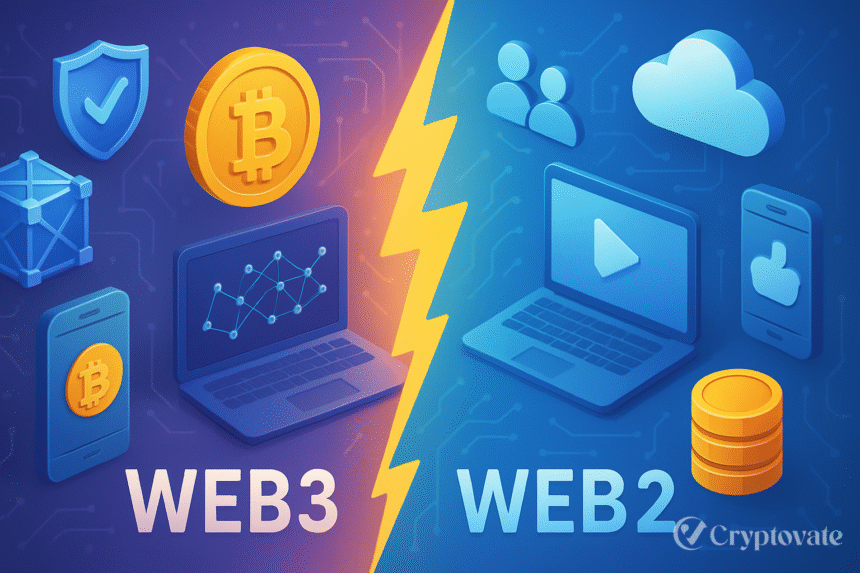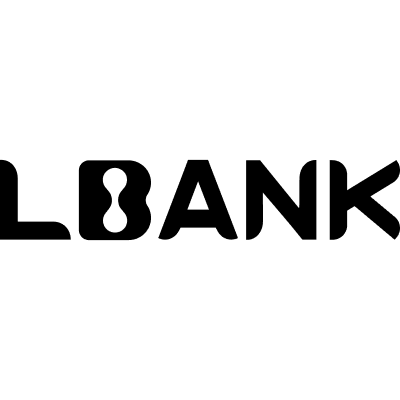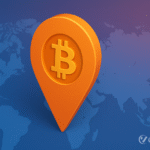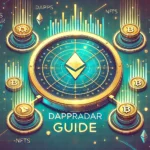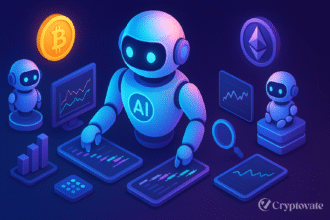– Ad –
| Getting your Trinity Audio player ready... |
The internet has undergone dramatic transformations, from the static pages of Web1 to the interactive, social media-driven Web2. Web3 is now emerging as a transformative paradigm, driven by blockchain technology and digital currencies. This article compares Web2 and Web3, delving into how crypto is reshaping the internet’s future with decentralization, user ownership, and innovative economic models. Written in an engaging and accessible style, this piece explores the potential and challenges of this shift.
Understanding Web2: The Current Internet
Web2 represents the internet we use today, defined by dynamic, user-generated content and centralized platforms. Giants like Google, Meta, and Amazon dominate, offering seamless experiences but often at a cost. Key characteristics include:
- Centralized Control: Companies manage servers, store user data, and set platform rules.
- User-Driven Content: From YouTube videos to Instagram posts, users create the content that fuels these platforms.
- Ad-Based Revenue: Monetization relies heavily on targeted ads, often compromising user privacy.
While Web2 has made the internet more interactive, it has drawbacks. Data breaches, privacy scandals, and monopolistic practices have sparked calls for a better alternative.
What is Web3? The Decentralized Vision
Web3 imagines a decentralized internet powered by blockchain technology. It aims to empower users by giving them control over their data, identities, and digital assets. Key features include:
- Decentralized Networks: Data is stored across distributed blockchains, reducing reliance on single entities.
- User Ownership: Cryptographic wallets and keys give users control over their data and assets.
- Token Economies: Cryptocurrencies and tokens drive transactions, governance, and incentives in Web3 ecosystems.
Web3 seeks to create a transparent, secure, and user-centric internet, leveraging crypto to redefine online interactions.
Web2 vs Web3: A Side-by-Side Comparison
| Feature | Web2 | Web3 |
| Control | Centralized (tech giants) | Decentralized (blockchain networks) |
| Data Ownership | Platform-controlled | User-controlled via wallets |
| Monetization | Ads, subscriptions | Tokens, NFTs, DeFi |
| Trust | Relies on platform trust | Trustless, blockchain-verified |
| Identity | Platform-managed accounts | Self-sovereign identities |
This shift from centralized control to user empowerment is at the heart of Web3’s promise.
How Crypto is Shaping the Internet’s Future
Cryptocurrencies and blockchain are the driving forces behind Web3, enabling transformative changes:
- Decentralized Finance (DeFi): Platforms like Uniswap and Compound allow users to lend, borrow, or trade without banks or intermediaries, promoting financial inclusion.
- Non-Fungible Tokens (NFTs): NFTs enable creators to sell digital art, music, or virtual goods directly, creating new revenue streams.
- Decentralized Autonomous Organizations (DAOs): DAOs replace traditional corporate governance with community-driven decisions, where token holders vote on outcomes.
- Enhanced Privacy: Blockchain’s encryption ensures secure transactions and data integrity, reducing risks of hacks and leaks.
- Interoperable Ecosystems: Protocols like Ethereum and Solana enable seamless interactions across platforms, fostering a connected digital world.
These innovations are redefining industries, from finance to gaming, and empowering users like never before.
Challenges Facing Web3
While promising, Web3 faces significant obstacles:
- Scalability Issues: Blockchains like Ethereum struggle with high fees and slow transaction speeds, hindering mass adoption.
- User Experience: Handling wallets and navigating decentralized applications can be challenging for users without technical expertise.
- Regulatory Uncertainty: Governments are still defining rules for crypto, with concerns about fraud and illicit activities.
- Environmental Concerns: Some blockchains, like Bitcoin, consume significant energy, though solutions like Ethereum’s proof-of-stake model aim to reduce this.
Addressing these challenges is crucial for Web3 to achieve mainstream success.
The Future of the Internet
Web3 is still evolving, but its impact is already visible. Major companies like Microsoft and Meta are exploring blockchain integrations, while startups are building decentralized alternatives to Web2 platforms. For example, platforms like Decentraland offer virtual worlds where users own and trade digital land using crypto. The gaming industry is also embracing Web3, with play-to-earn models like Axie Infinity rewarding players with tokens.
However, Web3’s success depends on overcoming technical barriers and gaining user trust. As blockchain technology matures and user interfaces improve, Web3 could redefine how we interact online, shifting power from corporations to individuals.
Why It Matters
The transition from Web2 to Web3 is more than a technological upgrade—it’s a philosophical shift. Web2 prioritizes convenience and scale but often sacrifices privacy and control. Web3, powered by crypto, emphasizes user sovereignty, transparency, and innovation. While Web2 will likely coexist with Web3 for years, the latter’s potential to create a fairer, more inclusive internet is undeniable.
Also Read: The Evolution of Blockchain: From Bitcoin to Web3
Conclusion
Web3, fueled by cryptocurrencies and blockchain, is poised to transform the internet from a centralized, corporate-dominated space to a decentralized, user-driven ecosystem. While Web2 excels in accessibility and scale, Web3 offers unmatched ownership, privacy, and economic opportunities. Despite challenges like scalability and regulation, the potential for a more equitable internet makes Web3 a compelling vision. As crypto continues to evolve, it will play a pivotal role in shaping the internet’s future, empowering users and redefining digital interactions.
FAQs
What is the main difference between Web2 and Web3?
Web2 is centralized, with companies controlling data and platforms, while Web3 is decentralized, using blockchain to give users control over their data and assets.
How does cryptocurrency fit into Web3?
Cryptocurrencies power Web3 by enabling transactions, governance, and incentives in decentralized ecosystems, such as DeFi and NFTs.
Is Web3 more secure than Web2?
Web3’s blockchain-based systems offer enhanced security through encryption and decentralization, reducing risks of data breaches compared to Web2’s centralized servers.
What are the biggest challenges for Web3 adoption?
Scalability, complex user experiences, regulatory uncertainties, and environmental concerns are major hurdles for Web3’s widespread adoption.
Can Web2 and Web3 coexist?
Yes, Web2 and Web3 are likely to coexist, with Web3 offering decentralized alternatives while Web2 platforms adapt to incorporate blockchain technology.


